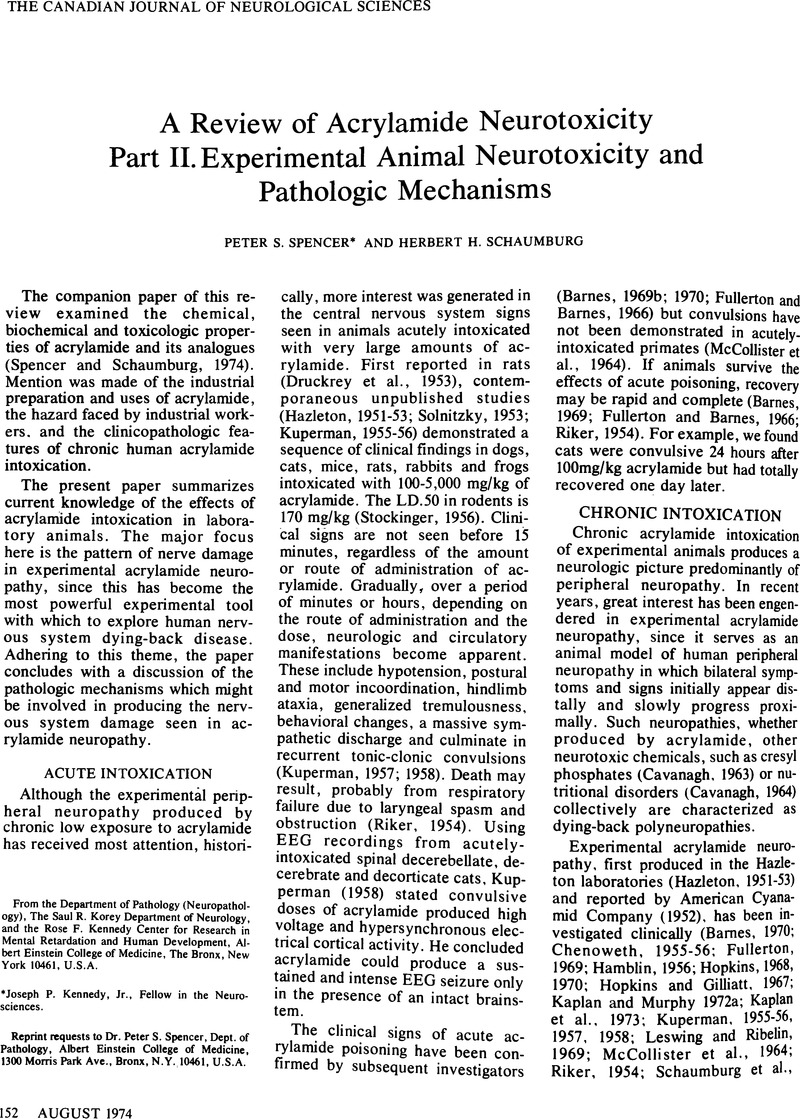Crossref Citations
This article has been cited by the following publications. This list is generated based on data provided by Crossref.
Spencer, Peter S.
and
Thomas, P. K.
1974.
Ultrastructural studies of the dying-back process II. The sequestration and removal by Schwann cells and oligodendrocytes of organelles from normal and diseased axons.
Journal of Neurocytology,
Vol. 3,
Issue. 6,
p.
763.
Spencer, Peter S.
and
Schaumburg, Herbert H.
1974.
A Review of Acrylamide Neurotoxicity Part I. Properties, Uses and Human Exposure.
Canadian Journal of Neurological Sciences / Journal Canadien des Sciences Neurologiques,
Vol. 1,
Issue. 2,
p.
143.
GRIFFITHS, I. R.
and
DUNCAN, I. D.
1975.
Chronic degenerative radiculomyelopathy in the dog*.
Journal of Small Animal Practice,
Vol. 16,
Issue. 1-12,
p.
461.
Edwards, Philippa M.
1975.
The distribution and metabolism of acrylamide and its neurotoxic analogues in rats.
Biochemical Pharmacology,
Vol. 24,
Issue. 13-14,
p.
1277.
Edwards, P.M.
1976.
The insensitivity of the developing rat foetus to the toxic effects of acrylamide.
Chemico-Biological Interactions,
Vol. 12,
Issue. 1,
p.
13.
SCHOTMAN, P.
GIPON, L.
JENNEKENS, F. G. I.
and
GISPEN, W. H.
1977.
POLYNEUROPATHIES AND CNS PROTEIN METABOLISM. II. CHANGES IN THE INCORPORATION RATE OF LEUCINE DURING ACRYLAMIDE INTOXICATION.
Neuropathology and Applied Neurobiology,
Vol. 3,
Issue. 2,
p.
125.
Milvy, Paul
and
Wolff, Mary
1977.
Mutagenic studies with acrylonitrile.
Mutation Research/Fundamental and Molecular Mechanisms of Mutagenesis,
Vol. 48,
Issue. 3-4,
p.
271.
Sharma, R.P.
and
Obersteiner, E.J.
1977.
Acrylamide cytotoxicity in chick ganglia cultures.
Toxicology and Applied Pharmacology,
Vol. 42,
Issue. 1,
p.
149.
1977.
Neuromuscular Function and Disorders.
p.
319.
Koch, Thomas
Schultz, Paul
Williams, Roger
and
Lampert, Peter
1977.
Giant axonal neuropathy: A childhood disorder of microfilaments.
Annals of Neurology,
Vol. 1,
Issue. 5,
p.
438.
GIPON, L.
SCHOTMAN, P.
JENNEKENS, F. G. I.
and
GISPEN, W. H.
1977.
POLYNEUROPATHIES AND CNS PROTEIN METABOLISM. I. DESCRIPTION OF THE ACRYLAMIDE SYNDROME IN RATS.
Neuropathology and Applied Neurobiology,
Vol. 3,
Issue. 2,
p.
115.
Mangan, D
and
Snyder, I S
1978.
The effect of acrylamide on human polymorphonuclear neutrophils in vitro..
Occupational and Environmental Medicine,
Vol. 35,
Issue. 4,
p.
305.
SJÖSTRAND, J.
FRIZELL, M.
and
RYDEVIK, B.
1978.
Peripheral Neuropathies.
p.
147.
Cabe, Patrick A.
and
Tilson, Hugh A.
1978.
Hind limb extensor response: A method for assessing motor dysfunction in rats.
Pharmacology Biochemistry and Behavior,
Vol. 9,
Issue. 1,
p.
133.
Jolicoeur, F.B.
Rondeau, D.B.
Hamel, E.
Butterworth, R. F.
and
Barbeau, A.
1979.
Measurement of Ataxia and Related Neurological Signs in the Laboratory Rat.
Canadian Journal of Neurological Sciences / Journal Canadien des Sciences Neurologiques,
Vol. 6,
Issue. 2,
p.
209.
Conroy, Peter J.
Von Burg, Rudy
Passalacqua, William
Penney, David P.
and
Sutherland, Robert M.
1979.
Misonidazole neurotoxicity in the mouse: Evaluation of functional, pharmacokinetic, electrophysiologic and morphologic parameters.
International Journal of Radiation Oncology*Biology*Physics,
Vol. 5,
Issue. 7,
p.
983.
Jennekens, F. G. I.
Veldman, H.
Schotman, P.
and
Gispen, W. H.
1979.
Sequence of motor nerve terminal involvement in acrylamide neuropathy.
Acta Neuropathologica,
Vol. 46,
Issue. 1-2,
p.
57.
Tilson, Hugh A.
and
Cabe, Patrick A.
1979.
The effects of acrylamide given acutely or in repeated doses on fore- and hindlimb function of rats.
Toxicology and Applied Pharmacology,
Vol. 47,
Issue. 2,
p.
253.
Howland, Richard D.
Vyas, Ivy L.
and
Lowndes, Herbert E.
1980.
The etiology of acrylamide neuropathy: Possible involvement of neuron specific enolase.
Brain Research,
Vol. 190,
Issue. 2,
p.
529.
BOULDIN, T. W.
HALL, C. D.
and
KRIGMAN, M. R.
1980.
PATHOLOGY OF DISULFIRAM NEUROPATHY.
Neuropathology and Applied Neurobiology,
Vol. 6,
Issue. 2,
p.
155.



